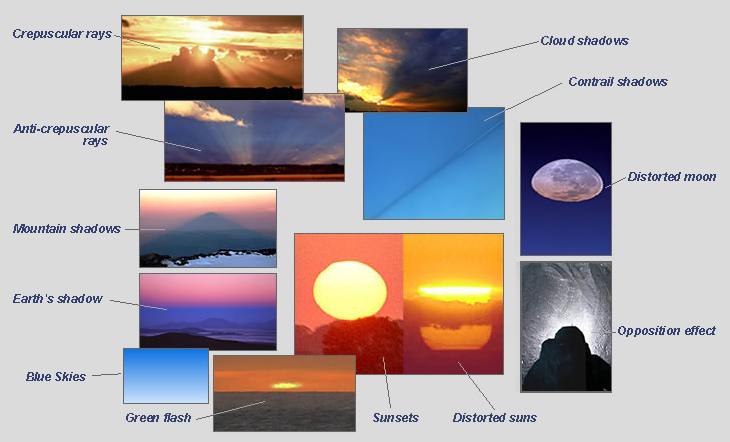Atmospheric Halos
Atmospheric Halos: Unveiling the Wonders of the Sky
Have you ever looked up at the sky and been captivated by the beautiful array of colors and shapes? Atmospheric halos are one of nature's most fascinating phenomena, responsible for creating stunning optical displays that often leave us in awe. In this article, we will delve deeper into the world of atmospheric halos, exploring their formation, characteristics, and the science behind their mesmerizing allure.
Understanding the Science Behind Atmospheric Halos
Atmospheric halos occur when sunlight interacts with tiny particles suspended in the Earth's atmosphere. These particles can range from dust and aerosols to moisture droplets. As sunlight passes through these particles, it undergoes a process called scattering, causing the sun's rays to become visible. This scattering effect is what gives rise to the vibrant colors we see in our skies, from the deep blues of a clear day to the fiery hues of a breathtaking sunset.
The Role of Refraction in Creating Spectacular Displays
In addition to scattering, another key factor in the formation of atmospheric halos is refraction. As sunlight travels through air at varying temperatures and densities, it bends or refracts. This bending of light is particularly pronounced during sunrise and sunset, when the sun is lower in the sky. The refraction of sunlight can create mesmerizing shapes and phenomena such as green flashes, where a brief burst of green light can be observed just as the sun dips below the horizon.
Exploring the Diversity of Atmospheric Halo Shapes
One of the most captivating aspects of atmospheric halos is their incredible variety of shapes and patterns. These optical phenomena can manifest as circular halos around the sun or moon, arcs, pillars, and even complete circles known as circumzenithal arcs. Each type of halo has its own distinct characteristics, formed by specific combinations of scattering and refraction. Understanding these different shapes allows us to appreciate the complexity and beauty of the atmospheric optics at play.
Atmospheric Halos on the Moon: A Lunar Enigma
Did you know that atmospheric halos can even be observed on the airless surface of the Moon? This seemingly paradoxical phenomenon is a result of perspective. When sunlight casts a shadow on the lunar surface, the contrast between the illuminated and shaded areas creates an apparent glow around the shadow. This captivating effect adds an additional layer of intrigue to our exploration of atmospheric halos, reminding us that the wonders of the sky extend far beyond our own planet.
Capturing the Magic: Photography and Atmospheric Halos
For photographers and enthusiasts alike, atmospheric halos provide a wealth of opportunities to capture stunning images. The intricate patterns and vibrant colors make for visually striking compositions. However, photographing these optical phenomena can be challenging due to their transient nature and sensitivity to atmospheric conditions. Patience, skill, and a keen eye are required to capture the magic of atmospheric halos through the lens.
The Influence of Weather and Climate on Atmospheric Halos
The formation and visibility of atmospheric halos are strongly influenced by weather and climate conditions. In regions with high levels of airborne particles, such as desert areas or volcanic regions, the likelihood of observing halos increases. Additionally, certain weather conditions, such as the presence of thin ice crystals in high-altitude clouds, can enhance the visibility and intensity of these optical displays. Understanding the connection between atmospheric conditions and halo formation adds another layer of complexity to this captivating natural phenomenon.
The Role of Technology in Studying Atmospheric Halos
Advancements in technology have significantly contributed to our understanding of atmospheric halos. Sophisticated instruments, such as spectrometers and polarimeters, allow scientists to measure and analyze the properties of light scattered by atmospheric particles. This data provides valuable insights into the composition and behavior of these particles, helping researchers unravel the intricacies of halo formation. Furthermore, the proliferation of high-quality cameras and image processing software has empowered citizen scientists to contribute to the study of atmospheric optics through their own observations and photographs.
Unveiling the Mysteries of Atmospheric Halos
Despite centuries of scientific exploration, atmospheric halos continue to intrigue and mystify us. Their ethereal beauty and ever-changing nature remind us of the boundless wonders that surround us. As we unravel the secrets behind their formation and characteristics, we deepen our appreciation for the intricate interplay of light, particles, and atmospheric conditions that give rise to these captivating optical displays. So, the next time you find yourself gazing at the sky, take a moment to marvel at the atmospheric halos that grace our world and contemplate the mysteries they hold.

Dust, small aerosols and moisture droplets scatter light to make the sun's rays visible and cloud and mountain shadowed air dark by comparison.
Air and very small particles scatter colours selectively to paint the blues of skies and fires of sunsets.
Air at varied temperatures and densities refracts the rays of setting suns and moons to fashion fantastic shapes and green flashes.
Perspective generates apparent glows around shadows even on the airless Moon.
Note: this article has been automatically converted from the old site and may not appear as intended. You can find the original article here.
Reference Atmospheric Optics
If you use any of the definitions, information, or data presented on Atmospheric Optics, please copy the link or reference below to properly credit us as the reference source. Thank you!
-
<a href="https://atoptics.co.uk/blog/atmospheric-halos-3/">Atmospheric Halos</a>
-
"Atmospheric Halos". Atmospheric Optics. Accessed on July 27, 2024. https://atoptics.co.uk/blog/atmospheric-halos-3/.
-
"Atmospheric Halos". Atmospheric Optics, https://atoptics.co.uk/blog/atmospheric-halos-3/. Accessed 27 July, 2024
-
Atmospheric Halos. Atmospheric Optics. Retrieved from https://atoptics.co.uk/blog/atmospheric-halos-3/.